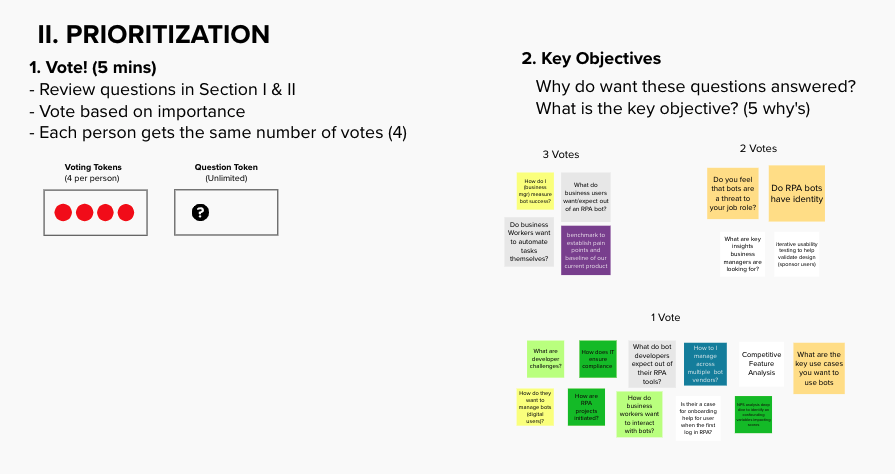Post-Acquisition Stakeholder Workshop
Context
After determining where there were misalignments with the team in the stakeholder interviews, I then conducted a stakeholder workshop with the team in order to identify assumptions and concerns associated with the product and it’s end users, which lead to priority mapping and a research roadmap for 2021.
The objective of the stakeholder workshop was twofold:
Identify research questions that key RPA stakeholders had about the project
Prioritize those research needs
Tools: Mural
Method Used: Design Thinking Workshop, Questions & Assumptions, Prioritization Mapping
Participants: 9 stakeholders
Timeframe: 1 week
Stakeholder Workshop Preparation
A 1-hour stakeholder workshop was conducted with the key stakeholders of the team. 9 IBM RPA team members participated in the workshop from different disciplines.
The workshop was divided into 3 parts which are described below:
1. Questions & Assumptions
Time Allotted: 30 minutes
In the first part of the workshop, our participants identified research questions & assumptions they had concerning the project. In order to get an overview of various kinds of research questions and needs, the Mural board was divided by category of research:
Exploratory Research: Big picture research focused on identifying needs of the users
Strategic Research: Research focused on better understanding needs of the users and beginning to identify the solution
Tactical/Design Research: Research focused on better understanding the solution and beginning to evaluate it with users
Operational Research: Ongoing research operations with users to understand, report on and socialize product usage data
2. Prioritization and Discussion
Time Allotted: 20 minutes
In the next part of the activity, the stakeholders were asked to read over the research questions and needs identified in the previous activity and vote on the research needs they deem most important. Each stakeholder was allotted 4 “voting tokens” in which they could vote on an individual research question/need.
After the voting concluded, we discussed the top research questions and needs identified by the group.
3. Prioritization Grid
Time Allotted: 10 minutes
Lastly, as a team, we plotted the top research questions and needs on a prioritization grid by (1) confidence in the team’s current knowledge or understanding of the research question or need on the x-axis, and (2) risk in not knowing the answering or getting it wrong on the y-axis.
During the readout of the workshop, the team was able to align on the top research priorities for the year.
I subsequently created a UX research roadmap that would outline the research projects that would be occurring for the upcoming quarters.


